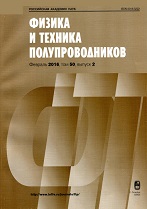|
|
Fizika i Tekhnika Poluprovodnikov, 2019, Volume 53, Issue 12, Page 1674
(Mi phts5333)
|
 |
|
 |
This article is cited in 11 scientific papers (total in 11 papers)
Amorphous, glassy, organic semiconductors
Synthesis and characterization of semiconductor polymer doped with FeCl$_{3}$, I$_{2}$
Bouabdallah Dahoa, Claudio Fontanesib, Massimo Messorib, Abdelkader Dehbia, Abdelkader Belfedalc
a Engineering Physics Laboratory, University Ibn Khaldoun, Tiaret, Algeria
b Departement of Engineering "Enzo Ferrari", University of Modena and Reggio Emilia, Via Pietro Vivarelli 10/1, 41125 Modena MO, Italy
c Laboratoire de Chimie Physique des Macromolecules et Interfaces Biologiques, Université de Mascara 2900, Algeria
Abstract:
The conductive polymer-based applications combine low cost, simple manufacturing procedure, flexibility and other properties. However, the low viscosity and solubility of these polymers make it difficult to produce layers by using industrial techniques. Among the most commonly used conjugated conductive organic polymers we can mention polyacetylene, polythiophene, polypyrrole, polyaniline, etc. In order to test them in further applications, new copolymers of thiophene and $p$-methoxybenzaldehyde were synthesized. The copolymers obtained will be characterized by several techniques (NMR, UV, CV, ATG, and electrical characterization). The study of the optical properties after doping is performed according to oxidation-reduction reactions by FeCl$_{3}$, I$_{2}$, in order to apprehend the redox behavior of this copolymer. The calculated value of energy gap Eg$^{\operatorname{CV}}$ of the studied polymers shows a decrease with the oxidation agent doping according to their oxidation potential, from 2.48 eV for the no doped copolymer passing by 2.22 eV for the copolymer doped with I$_{2}$ and up to 1.5 eV for the copolymer doped with FeCl$_{3}$. The decrease of the energy gap with the doping (FeCl$_{3}$ and I$_{2}$) corresponds to the increase of the conductivity with doping from 2.85 $\cdot$ 10$^{-5}$ S $\cdot$ m$^{-1}$ for no doped polymer to 7.86 $\cdot$ 10$^{-5}$ S $\cdot$ m$^{-1}$ for copolymer doped with I$_{2}$ and 1.55 $\cdot$ 10$^{-4}$ S $\cdot$ m$^{-1}$ for copolymer doped with FeCl$_{3}$.
Keywords:
thiophene, CV, $p$-methoxybenzaldehyde, FeCl$_{3}$ and I$_{2}$.
Received: 16.05.2019
Revised: 30.07.2019
Accepted: 05.08.2019
Citation:
Bouabdallah Daho, Claudio Fontanesi, Massimo Messori, Abdelkader Dehbi, Abdelkader Belfedal, “Synthesis and characterization of semiconductor polymer doped with FeCl$_{3}$, I$_{2}$”, Fizika i Tekhnika Poluprovodnikov, 53:12 (2019), 1674; Semiconductors, 53:12 (2019), 1656–1664
Linking options:
https://www.mathnet.ru/eng/phts5333 https://www.mathnet.ru/eng/phts/v53/i12/p1674
|


| Statistics & downloads: |
| Abstract page: | 38 | | Full-text PDF : | 9 |
|





 Contact us:
Contact us: Terms of Use
Terms of Use
 Registration to the website
Registration to the website Logotypes
Logotypes








 Citation in format
Citation in format 
